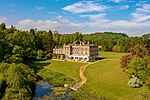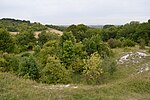Knocking Hoe

Knocking Hoe is a 7.7 hectare National Nature Reserve and biological Site of Special Scientific Interest near Pegsdon in Bedfordshire. It is mentioned in A Nature Conservation Review. It is part of the Chilterns Area of Outstanding Natural Beauty, and is managed by Natural England.The site is a flat bottomed valley with steep sides. The unimproved chalk grassland has several nationally rare plants, including moon carrot, spotted catsear, field fleawort, burnt tip orchid and pasque flower. There are also a variety of wild flowers such as the autumn lady’s tresses, which has been studied on the site for over fifty years. The ancient strip lynchet field system is of archaeological interest.There is access by a footpath from Hitchin Road in Pegsdon.
Excerpt from the Wikipedia article Knocking Hoe (License: CC BY-SA 3.0, Authors, Images).Knocking Hoe
Wood Lane,
Geographical coordinates (GPS) Address External links Nearby Places Show on map
Geographical coordinates (GPS)
| Latitude | Longitude |
|---|---|
| N 51.963 ° | E -0.355 ° |
Address
Knocking Hoe National Nature Reserve
Wood Lane
SG5 3QH
England, United Kingdom
Open on Google Maps








